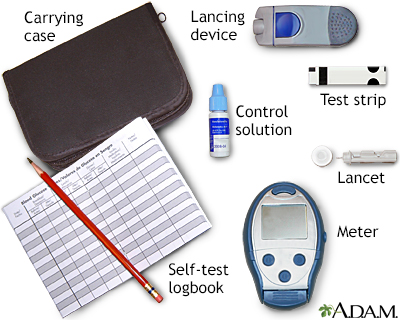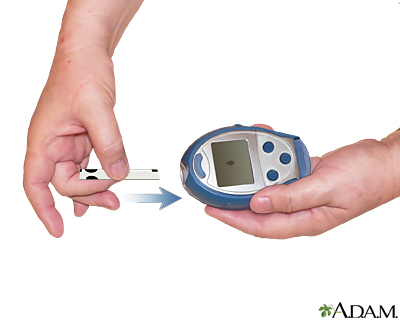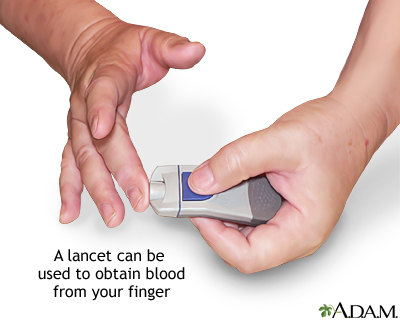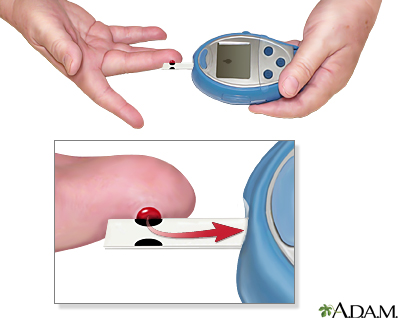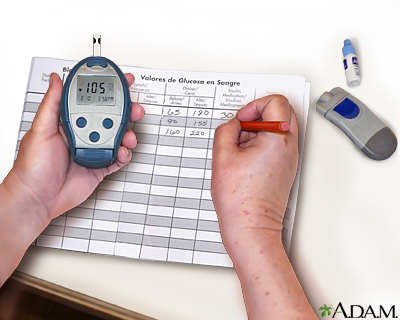Diabetes Symptoms - Headache
Diabetes is a long-term (chronic) disease in which the body cannot regulate the amount of sugar in the blood.
Video Transcript
Diabetes - Animation
Causes
Insulin is a hormone produced by the pancreas to control blood sugar. Diabetes can be caused by too little insulin, resistance to insulin, or both.
To understand diabetes, it is important to first understand the normal process by which food is broken down and used by the body for energy. Several things happen when food is digested and absorbed:
- A sugar called glucose enters the bloodstream. Glucose is a source of fuel for the body.
- An organ called the pancreas makes insulin. The role of insulin is to move glucose from the bloodstream into muscle, fat, and other cells, where it can be stored or used as fuel.

Food and insulin release
People with diabetes have high blood sugar because their body cannot move sugar from the blood into muscle and fat cells to be burned or stored for energy, and/or because their liver makes too much glucose and releases it into the blood. This is because either:
- Their pancreas does not make enough insulin
- Their cells do not respond to insulin normally
- Both of the above
There are two major types of diabetes. The causes and risk factors are different for each type:

Type I diabetes
- Type 1 diabetes is less common. It can occur at any age, but it is most often diagnosed in children, teens, or young adults. In this disease, the body makes little or no insulin. This is because the pancreas cells that make insulin stop working. Daily injections of insulin are needed. The exact cause of the failure to make enough insulin is unknown.
Type 1 diabetes
Type 1 diabetes is a lifelong (chronic) disease in which there is a high level of sugar (glucose) in the blood.
 ImageRead Article Now Book Mark Article
ImageRead Article Now Book Mark Article - Type 2 diabetes is more common. It most often occurs in adulthood, but because of high obesity rates, children and teens are now being diagnosed with this disease. Some people with type 2 diabetes do not know they have it. With type 2 diabetes, the body is resistant to insulin and doesn't use insulin as well as it should. Not all people with type 2 diabetes are overweight or obese.
Type 2 diabetes
Type 2 diabetes is a lifelong (chronic) disease in which there is a high level of sugar (glucose) in the blood. Type 2 diabetes is the most common f...
 ImageRead Article Now Book Mark Article
ImageRead Article Now Book Mark Article - There are other causes of diabetes, and some people cannot be classified as type 1 or type 2.
Gestational diabetes is high blood sugar that develops at any time during pregnancy in a woman who does not already have diabetes.
Gestational diabetes
Gestational diabetes is high blood sugar (glucose) that starts or is first diagnosed during pregnancy.

If your parent, brother, or sister has diabetes, you may be more likely to develop the disease.
Symptoms
A high blood sugar level can cause several symptoms, including:
- Blurry vision
- Excess thirst
- Fatigue
- Frequent urination
- Hunger
- Weight loss
- Headaches
Because type 2 diabetes develops slowly, some people with high blood sugar have no symptoms.
Symptoms of type 1 diabetes develop over a short period. People may be very sick by the time they are diagnosed.
After many years, diabetes can lead to other serious problems. These problems are known as diabetes complications, and include:
- Eye problems, including trouble seeing (especially at night), light sensitivity, and blindness
Eye problems
Diabetes can harm the eyes. It can damage the small blood vessels in the retina, the back part of your eye. This condition is called diabetic retin...
 ImageRead Article Now Book Mark Article
ImageRead Article Now Book Mark Article - Sores and infections of the leg or foot, which if untreated, can lead to amputation of the leg or foot
- Damage to nerves in the body, causing pain, tingling, a loss of feeling, problems digesting food, and erectile dysfunction
Damage to nerves in the body
Nerve damage that occurs in people with diabetes is called diabetic neuropathy. This condition is a complication of diabetes.
 ImageRead Article Now Book Mark Article
ImageRead Article Now Book Mark Article - Kidney problems, which can lead to kidney failure
Kidney problems
Kidney disease or kidney damage often occurs over time in people with diabetes. This type of kidney disease is called diabetic nephropathy.
 ImageRead Article Now Book Mark Article
ImageRead Article Now Book Mark ArticleKidney failure
Chronic kidney disease is the slow loss of kidney function over time. The main job of the kidneys is to remove wastes and excess water from the body...
 ImageRead Article Now Book Mark Article
ImageRead Article Now Book Mark Article - Weakened immune system, which can lead to more frequent infections
- Increased chance of having a heart attack or stroke
Heart attack
Most heart attacks are caused by a blood clot that blocks one of the coronary arteries. The coronary arteries bring blood and oxygen to the heart. ...
 ImageRead Article Now Book Mark Article
ImageRead Article Now Book Mark ArticleStroke
A stroke occurs when blood flow to a part of the brain stops. A stroke is sometimes called a "brain attack. " If blood flow is cut off for longer th...
 ImageRead Article Now Book Mark Article
ImageRead Article Now Book Mark Article

Diabetic retinopathy
Exams and Tests
A urine analysis may show high blood sugar. But a urine test alone does not diagnose diabetes.
Urine analysis
Urinalysis is the physical, chemical, and microscopic examination of urine. It involves a number of tests to detect and measure various compounds th...

Your health care provider may suspect that you have diabetes if your blood sugar level is higher than 200 mg/dL (11.1 mmol/L). To confirm the diagnosis, one or more of the following tests must be done.
Blood tests:
- Fasting blood glucose level. Diabetes is diagnosed if the fasting glucose level is 126 mg/dL (7.0 mmol/L) or higher on two different tests. Levels between 100 and 125 mg/dL (5.5 and 7.0 mmol/L) are called impaired fasting glucose or prediabetes. These levels are risk factors for type 2 diabetes.
Fasting blood glucose level
A blood sugar test measures the amount of sugar (glucose) in a sample of your blood. Glucose is a major source of energy for most cells of the body, ...
 ImageRead Article Now Book Mark Article
ImageRead Article Now Book Mark Article - Hemoglobin A1C (A1C) test. Normal is less than 5.7%; prediabetes is 5.7% to 6.4%; and diabetes is 6.5% or higher.
Hemoglobin A1C
A1C is a lab test that shows the average level of blood sugar (glucose) over the previous 3 months. It shows how well you are controlling your blood...
 ImageRead Article Now Book Mark Article
ImageRead Article Now Book Mark Article - Oral glucose tolerance test. Diabetes is diagnosed if the glucose level is 200 mg/dL (11.1 mmol/L) or higher 2 hours after drinking a special 75 gram sugar drink (this test is used more often for type 2 diabetes).
Oral glucose tolerance test
The glucose tolerance test is a lab test to check how your body moves sugar from the blood into tissues like muscle and fat. The test is often used ...
 ImageRead Article Now Book Mark Article
ImageRead Article Now Book Mark Article
Screening for type 2 diabetes in people who have no symptoms is recommended for:
- Overweight children who have other risk factors for diabetes, starting at age 10 and repeated every 3 years
- Overweight or obese adults (BMI of 25 or higher) starting at age 35
- Overweight women who have other risk factors such as high blood pressure who are planning to become pregnant
- All adults over age 45, repeated every 3 years or at a younger age if the person has risk factors such as high blood pressure, or having a mother, father, sister, or brother with diabetes
Treatment
Type 2 diabetes can sometimes be reversed with lifestyle changes, especially losing weight with exercise and by eating healthier foods. Some cases of type 2 diabetes can also be improved with weight loss surgery.
There is no cure for type 1 diabetes (except for a pancreas or islet cell transplant).
Treating either type 1 diabetes or type 2 diabetes involves nutrition, activity and medicines to control blood sugar level.
Everyone with diabetes should receive proper education and support about the best ways to manage their diabetes. Ask your provider about seeing a certified diabetes educator (CDE).
Getting better control over your blood sugar, cholesterol, and blood pressure levels helps reduce the risk for kidney disease, eye disease, nervous system disease, heart attack, and stroke.
To prevent diabetes complications, visit your provider at least 2 to 4 times a year. Talk about any problems you are having. Follow your provider's instructions on managing your diabetes.
Support Groups
Many resources can help you understand more about diabetes. If you have diabetes, you can also learn ways to manage your condition and prevent diabetes complications.
Resources
The following sites provide further information on diabetes:American Diabetes Association -- diabetes. orgCenters for Disease Control and Prevention ...

Outlook (Prognosis)
Diabetes is a lifelong disease for most people who have it.
Tight control of blood glucose can prevent or delay diabetes complications. But these problems can occur, even in people with good diabetes control.
Possible Complications
After many years, diabetes can lead to serious health problems:
- You could have eye problems, including trouble seeing (especially at night), and light sensitivity. You could become blind.
- Your feet and skin can develop sores and infections. After a long time, your foot or leg may need to be amputated. Infection can also cause pain and itching in other parts of the body.
- Diabetes may make it harder to control your blood pressure and cholesterol. This can lead to a heart attack, stroke, and other problems. It can become harder for blood to flow to your legs and feet.
- Nerves in your body can get damaged, causing pain, tingling, and numbness.
- Because of nerve damage, you could have problems digesting the food you eat. You could feel weakness or have trouble going to the bathroom. Nerve damage can make it harder for men to have an erection.
- High blood sugar and other problems can lead to kidney damage. Your kidneys may not work as well as they used to. They may even stop working so that you need dialysis or a kidney transplant.
- Your immune system can weaken, which can lead to frequent infections.
Prevention
Keeping an ideal body weight and an active lifestyle may prevent or delay the start of type 2 diabetes. If you're overweight, losing just 5% of your body weight can reduce your risk. Some medicines can also be used to delay or prevent the start of type 2 diabetes.
At this time, type 1 diabetes cannot be prevented. But there is promising research that shows type 1 diabetes may be delayed in some high risk people.
Reviewed By
Brent Wisse, MD, board certified in Metabolism/Endocrinology, Seattle, WA. Internal review and update on 06/03/2021 by David Zieve, MD, MHA, Medical Director, Brenda Conaway, Editorial Director, and the A.D.A.M. Editorial team. Editorial update 09/03/2021.
American Diabetes Association. 2. Classification and Diagnosis of Diabetes: Standards of Medical Care in Diabetes-2021. Diabetes Care. 2021 Jan;44(Suppl 1):S15-S33. PMID: 33298413 pubmed.ncbi.nlm.nih.gov/33298413/.
Atkinson MA, Mcgill DE, Dassau E, Laffel L. Type 1 diabetes mellitus. In: Melmed S, Auchus, RJ, Goldfine AB, Koenig RJ, Rosen CJ , eds. Williams Textbook of Endocrinology. 14th ed. Philadelphia, PA: Elsevier; 2020:chap 36.
Riddle MC, Ahmann AJ. Therapeutics of type 2 diabetes mellitus. In: Melmed S, Auchus, RJ, Goldfine AB, Koenig RJ, Rosen CJ, eds. Williams Textbook of Endocrinology. 14th ed. Philadelphia, PA: Elsevier; 2020:chap 35.
US Preventive Services Task Force, Davidson KW, Barry MJ, Mangione CM, et al. Screening for prediabetes and type 2 diabetes: US Preventive Services Task Force recommendation statement. JAMA. 2021;326(8):736-743. PMID: 34427594 pubmed.ncbi.nlm.nih.gov/34427594/.















